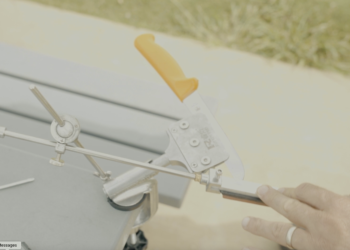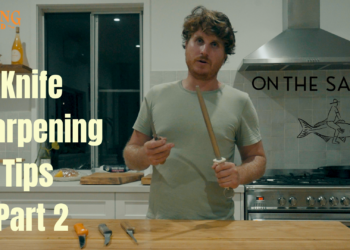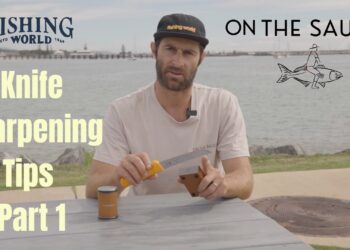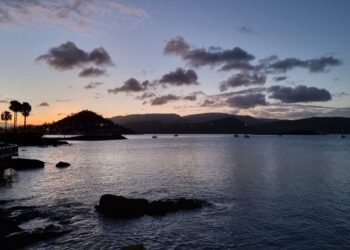SARATOGA, often referred to as “living fossils”, are a freshwater sportfish many Aussie anglers have on their bucket list of captures. Once you experience the thrills associated with ‘toga fishing, you tend to want to have another crack at them. They are fairly addictive fish … One of the things I really enjoy about chasing saratoga has to do with the spectacular waterways they inhabit. Some spots are very easy to access, others are very remote and suit adventurous anglers with an urge to find rarely fished waters.
Saratoga can be found from southern Queensland north all the way around Cape York and on to Darwin. They inhabit small sweet-water creeks and rivers, billabongs and impoundments. Most of my ‘toga trips have been based around Darwin covering spots such as Corroboree Billabong, Manton Dam and the numerous billabongs found in Kakadu National Park.
Working as a fishing guide has enabled me to access some truly remote waters. The three years I spent working with Russell, Roz and Darren Kenny at their fishing camp in Arnhem Land saw me experience rarely touched waters. Russell has a true sense of adventure and with the use of 4X4s and quad bikes he pushed into places where no vehicle tracks have ever been before. He found some great remote waters with lots of willing saratoga (along with barra and sooty grunter). Only a handful of lucky anglers got to experience this type of wilderness fishing. I’m glad I was one of them. We also came across rock art that reminded us others had walked these places long before we did.
The one spot that sticks in my mind is an unnamed billabong located on the edge of the Arafura Swamp which held countless numbers of ‘toga. Russell had a small flat bottomed punt that was left upturned at the water’s edge and we would drive there with our clients and an electric motor, rig everything up and commence casting. It would end in what can only be described as “’toga madness” with a lure rarely making it back to the punt without receiving attention from the hordes of fish that called this water home. Scores of 50+ ‘toga a session were common.
The other saratoga spot that’s special to me is Goose Creek on Melville Island. I’ve been up and down this waterway many times and always enjoyed taking guests there to target ‘togas. Its clear fresh water reaches lined with thousands of waterlilies and shaded by tall paperbark forests meant you could often watch as a ‘toga either smashed the lure the moment it touched the water or instead followed it all the way to the boat only to charge in at the last moment. And Goose Creek is one of THE best spots to throw a fly for a saratoga (or barra for that matter). Most of the saratoga I see average around the 50cm to 70cm range, with any over 80cm a true trophy fish. A typical 70cm fish weighs around 2kg, so while ‘toga aren’t up there in the heavyweight division, the country they inhabit often requires a heavy-handed approach.
Fly-fishing or casting weedless lures in the lily-choked billabongs often results in the fish wrapping itself around the vegetation and escaping. Some fly anglers use a 10wt rod with the hope of getting the ‘toga’s head up so they can try to skip it across the top of the waterlilies. Fishing the lilies can be spectacular with the fish smashing the fly/lure as it touches an opening between the thick mats of lily pads, but it’s the toughest of places to actually land one. Other locations are a lot kinder. It’s here that you can use fishing tackle more suitable to the ‘toga’s size and weight. Saratoga will take a large range of lures/flies. I won’t attempt to name all the ones I’ve seen work but will instead provide a general indication of what to look for.
Surface lures
‘Toga love surface lures and often have eyes only for something that splutters and bloops its way across the top. The only drawback with surface lures is you tend to get a lot of missed hook-ups. Soft plastic frogs and mice that come rigged weedless are popular. Plastics you can DIY rig weedless and use for surface presentations are ideal amongst heavy cover such as waterlilies. In more open waters, poppers, fizzers and surface walkers in sizes from 30mm to 120mm will attract attention. Halco Roosta poppers, Bill’s Fuzzbugs and Cultiva Tango Dancers are a few such lures in my tackle box.
Diving lures
Some days you’ll need to get below the surface to entice a strike. Any quality lure that has a diving depth from 1m all the way down to 5m can do the trick for you. A diver in sizes 40mm-100mm should allow you to cover most options. Reidy’s Little Lucifer, Jackall Squirrels and Lucky Craft Pointers are proven performers.
Spinners
Spinnerbaits and other bladed lures with a rubber skirt (such as a Mumbler) are another great choice to cast at ‘togas as they are generally weed and snag resistant. Go for models in ¼ to ½ oz head size.
Soft Plastics
Grubs and wrigglers, worms, yabbies and shrimp patterns all work on saratoga. I reckon you could spend a lot of your lifetime trying to give them all a run but if I were only to have one choice it would be a Berkley Gulp 5” Jerkshad. ‘Toga love the juice these softies come in, so much so that they will pick the baits up off the bottom and carry them around for ages before letting go. Rigged weedless on a 2/0 or 3/0 hook and around a 1/4oz of weight, the Gulps are my go-to lure when others don’t produce.
Bait
We’ve discovered while sitting in the shade enjoying our lunch that ‘toga have a very peculiar habit of finding human foods irresistible. Corned beef, roast beef, salami, silverside, smoked salmon, tasty cheese and cooked chicken skin will get an instant response if there is a ‘toga anywhere near the area. A 1/4oz jig head loaded with one of the above snacks lowered over the side and slowly bobbed will almost always get whacked. I even saw an 80cm barra scoff a tasty piece of silverside one day. Strange but true. However, fishing for ‘togas with lures is probably the better way to go …
Tackle
Your standard tropical baitcaster rod around six-foot in length and rated around 6kg teamed up with a smooth casting reel loaded with 10 to 15kg braid will handle most saratoga you encounter. Equally effective is a six-kilo spin outfit. These outfits are probably overkill for the ‘toga but you never know when a barra will crash the party. Waterways with less lilies and snags in them allow you to downsize your tackle. Rods rated 3-4kg and reels loaded with four or 5-kilo braid are a good choice. Saratoga have small fine teeth and aren’t that hard on leaders but with barra around I run about a metre of 30lb. Make sure your hooks are sharp. A mate of mine once told me that he had never heard of a person losing a fish because the hook was too sharp. Wise words …
Anyway, I hope this article inspires you get out there and have a crack at these great little sportfish. I guarantee you won’t be disappointed …



















